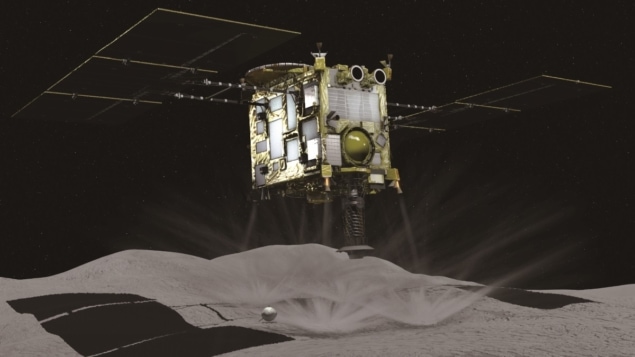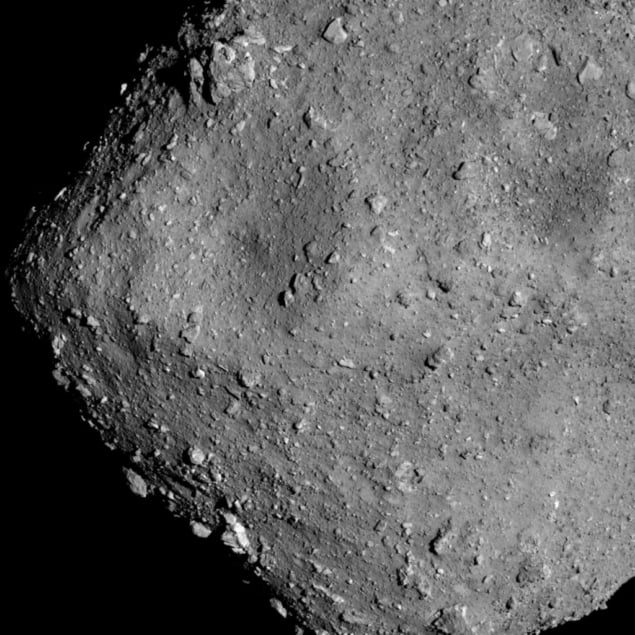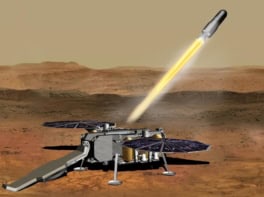
There is a scene in the film Hayabusa (2011) that brilliantly gives the audience a tantalizing first-hand experience of a space mission. It’s 20 November 2005 and the Japanese spacecraft Hayabusa (which means peregrine falcon) is attempting to touch down and grab a sample from the asteroid Itokawa. As strings play gently in the background, film director Yukihiko Tsutsumi keeps cutting smoothly between shots of the slow descent of Hayabusa towards the asteroid’s surface, and the intense concentration of scientists and engineers gathered around monitors in mission control.
Then something goes wrong, and the strings are replaced by a low, pulsing synthesizer. And now the director cruelly stops cutting back to show us what is happening with the spacecraft. Instead — frustratingly, maddeningly — we are trapped on earth with the mission control team, 180 million miles from Itokawa, and desperate to know what is happening.
Hayabusa2, a follow-up to that dramatic first Hayabusa mission launched by the Japanese space agency, JAXA, is now about to attempt to collect a rock sample from the asteroid Ryugu. In a show of country-wide excitement normally reserved for a big game in the World Cup, Japan will hold its collective breath on Friday 22 February for the planned touchdown at around 8 a.m. local time (11 p.m. on the Thursday evening in the UK).
If we find organic matter in it, this is the material that would eventually become life on Earth
Makoto Yoshikawa
The first Hayabusa spacecraft eventually returned to Earth with 1500 miniscule grains of rock from Itokawa. Apart from the rocks and soil that the Americans and Soviets brought back from the moon between 1969 and 1976, it was the first time a sample had been obtained from the surface of a body in space
“The original Hayabusa had lots of serious troubles,” says Makoto Yoshikawa, the mission manager for Hayabusa2. “But we were able to overcome these problems, and it came back to earth in 2010, seven years after launch. Hayabusa itself went into the atmosphere and burned up, but it successfully got the sample back to the ground. Many Japanese people were very moved to see such a thing.”
That underdog spirit captivated the Japanese public at the time, and has now extended to the Hayabusa2 mission. Yoshikawa wistfully compares Hayabusa2 to OSIRIS-REx, the US spacecraft that is preparing to touch down on the asteroid Bennu next year. “Our spacecraft is much smaller than theirs, and our budget is very small,” he notes. “But our mission is very ambitious, very challenging.”
Both Hayabusa2 and OSIRIS-REx have the same mission, says Yoshikawa: to go to an asteroid and get a sample. “But Hayabusa2 is more challenging because we have three small rovers and one small lander, and we have an impactor.”
The first two rovers landed last September. They explored Ryugu by “hopping”, becoming the first probes to send back pictures from the surface of an asteroid. The following month Hayabusa2 deployed a German-French package of instruments called the Mobile Asteroid Surface Scout (MASCOT), with the final rover scheduled to be sent down to Ryugu in July or later this year.

In addition to the sampling device that will be used on 22 February, Hayabusa2 also carries an impactor. This is a high-speed projectile, due to be fired in March or April, that will make a crater on the asteroid and enable Hayabusa2 to collect “fresh” material from beneath the surface.
Bold mission
Stephan Ulamec, the payload manager for MASCOT — and, before that, a member of the European team that landed Philae on the comet Churyumov-Gerasimenko in 2014 — praises Japan for its willingness to do “bold missions” and “take risks”. Yoshikawa agrees, but only up to a point. “In fact, now Japan is becoming rather conservative,” he thinks. “Twenty or thirty years ago when we started Hayabusa, and again in 2006 when we began Hayabusa2, challenge was a good thing. But I think if we proposed Hayabusa2 now, it would be difficult to pass the review.”
Attitudes may change after Hayabusa2 returns to Earth in December 2020. Ryugu is a C-type asteroid that dates back to the earliest days of the solar system, and the mission has already produced a number of surprises. But Yoshikawa wonders if the biggest revelation might be yet to come.
“When we first saw Ryugu last June we were very surprised, because the shape is a spinning top and we never imagined that. Our next surprise was that the surface of the asteroid is covered by lots of boulders and rocks,” he explains. “Maybe the next surprise will be the sample. If we find organic matter in it, this is the material that would eventually become life on Earth. We want to find that original material.”

Japan launches second asteroid mission
Physics World readers can follow the progress of Hayabusa2 via the mission’s Twitter account. And Yukihiko Tsutsumi’s film provides a 140-minute insight into the original Hayabusa mission and Japan’s unique science culture. It was the first of three feature-length films made about Hayabusa, although it is the only one to have been given English subtitles, and it is available from various streaming services.
“The people in the films are totally fictitious, but they’re all based on the actual things that Hayabusa did,” says Yoshikawa, “Some parts are true, some parts are fiction. I think these films are very nice; they show the important points about the human relationships.”



